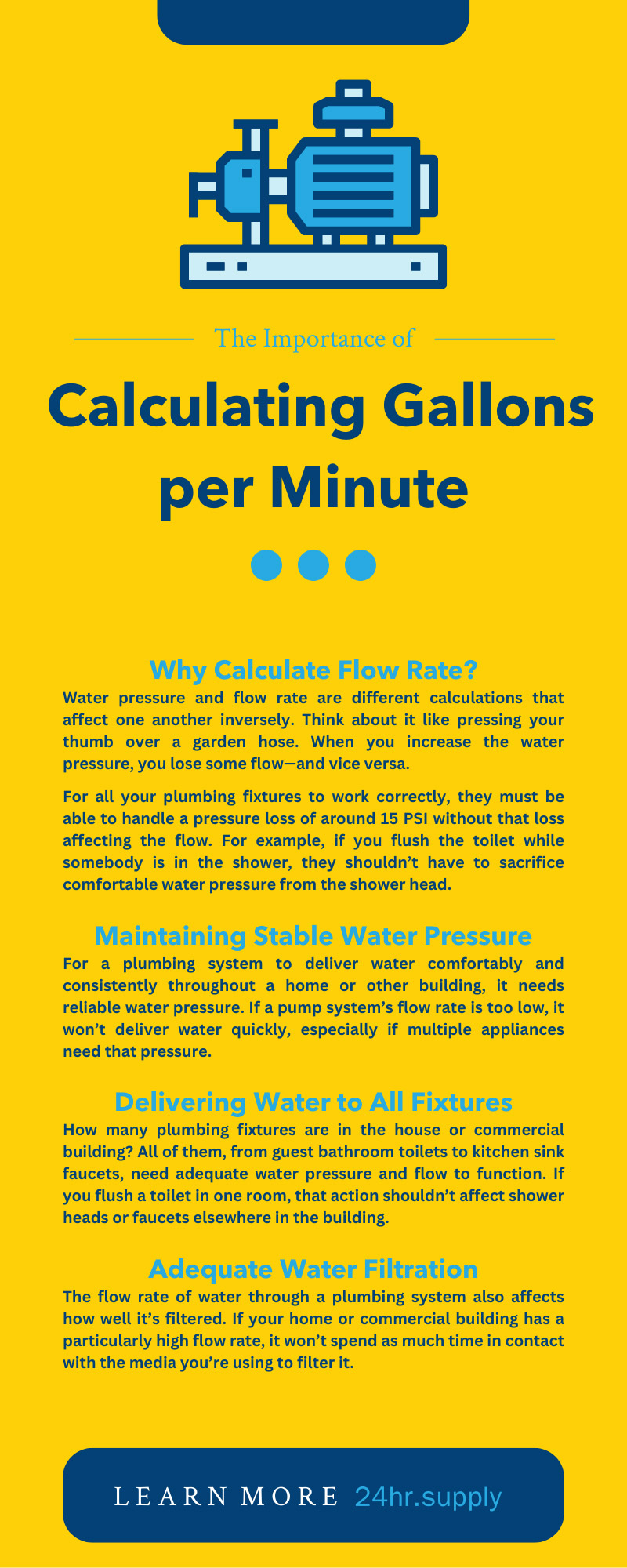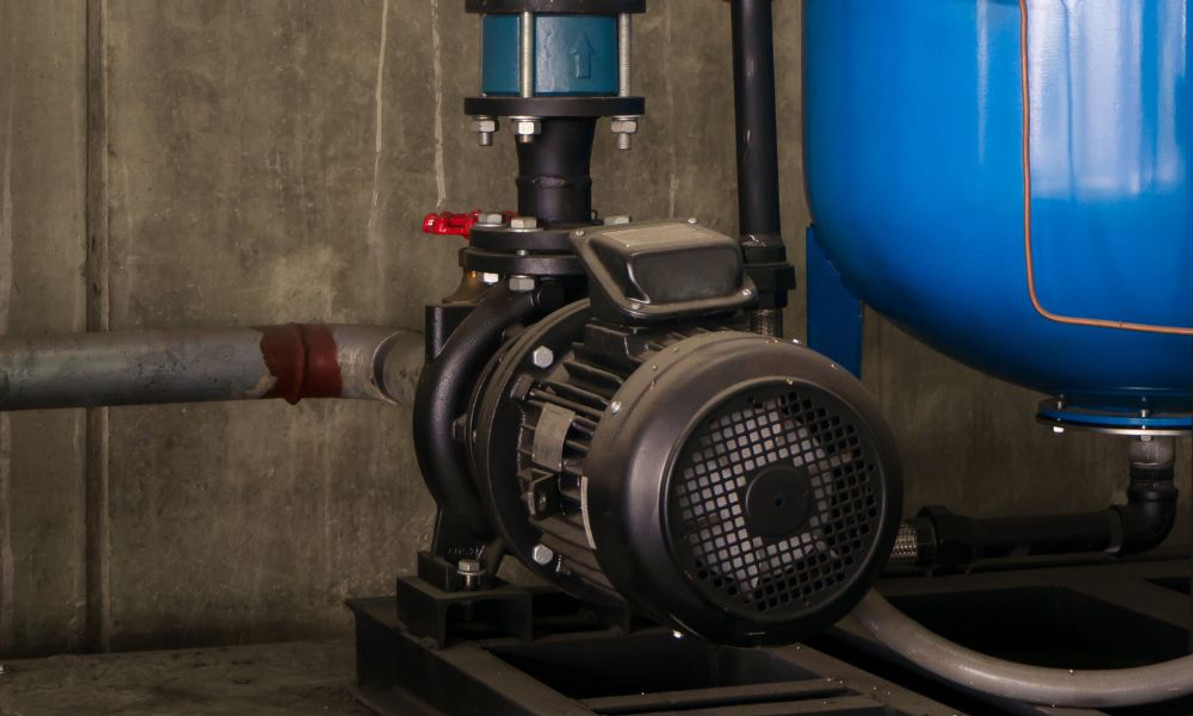The Importance of Calculating Gallons per Minute
What is a liquid flow rate, and why is it so crucial for a home’s water system?
The liquid flow rate measures the volume of liquid that passes through a given cross-section of the system. It’s calculated in gallons per minute and helps determine a system’s water pressure.
A home or commercial building with low water pressure can waste a great deal of water. Knowing the system’s ideal flow rate is essential to maintaining energy efficiency and keeping the system running. It’s important to calculate the flow rate in gallons per minute and compare those results with the plumbing system’s ideal liquid flow rate. Let’s learn more about how to make those calculations—and why they’re so important.
Calculating Flow Rate
While there are apps to calculate everything nowadays, it’s helpful to know how to do those calculations. Which variables go into calculating a pump system’s flow rate in gallons per minute?
The two most obvious variables are in the measurement: volume (in gallons) and time (in one minute). The formula for calculating gallons per minute (GPM) is 60 divided by the number of seconds it takes you to fill a container with a volume of one gallon.
The Bucket Method
One easy way to calculate a pump’s flow rate is with a stopwatch and a one-gallon container, like a bucket. Use your stopwatch to time exactly how long it takes to fill that bucket. Repeat this process three or four times and determine the average of your results to get a more reliable number. If it takes an average of five seconds to fill a one-gallon bucket or jug, divide 60 by five to get 12 gallons per minute.
The Pressure Tank Method
For another way to calculate the flow rate in GPM, you will need to know the specifications of the water pressure tank. This includes its capacity, gallon drawdown, and water pressure in pounds per square inch (PSI). This information is generally available from the tank manufacturer.
The formula for finding your GPM number is slightly different with this method. You divide the gallon drawdown number (in gallons) by the time on your stopwatch (in minutes).
To get started, you’ll need to empty out the pressure tank. When you hear that pressure switch turn on, start your stopwatch. Then, when you hear the switch flip off, stop the watch, and record the time in minutes.
Let’s say your gallon drawdown is 20 gallons, and it took five minutes for the pressure switch to turn off. The formula described above will give you a GPM of four.
Top Tip:
Remember to be as accurate as possible with your timing. Five minutes and 20 seconds comes out to roughly 5.33 minutes, four minutes and 30 seconds is exactly 4.5 minutes, and so on.
Why Calculate Flow Rate?
Water pressure and flow rate are different calculations that affect one another inversely. Think about it like pressing your thumb over a garden hose. When you increase the water pressure, you lose some flow—and vice versa.
For all your plumbing fixtures to work correctly, they must be able to handle a pressure loss of around 15 PSI without that loss affecting the flow. For example, if you flush the toilet while somebody is in the shower, they shouldn’t have to sacrifice comfortable water pressure from the shower head.
To keep that flow consistent, it’s wise to know both flow rates of your plumbing system: service and peak.
- Service flow rate is the standard flow rate on an average day.
- Peak flow rate refers to the liquid flow rate when all appliances—toilets, showers, sinks, et al.—are in use. It’s the maximum that your system can handle.
The Importance of Adequate Water Flow
Why are these numbers significant to a home or commercial building’s plumbing system? What do they affect?
Maintaining Stable Water Pressure
For a plumbing system to deliver water comfortably and consistently throughout a home or other building, it needs reliable water pressure. If a pump system’s flow rate is too low, it won’t deliver water quickly, especially if multiple appliances need that pressure.
Are you working in a home or building with low water pressure? As the name implies, a booster pump system can boost the water pressure using a motorized impeller to get water flowing more powerfully and quickly.
Meanwhile, if the flow rate is too high, the water pressure could also get too high, which puts excess strain on the plumbing system. If there’s too much liquid rushing through the pipes at too high a speed, they could burst.
Delivering Water to All Fixtures
How many plumbing fixtures are in the house or commercial building? All of them, from guest bathroom toilets to kitchen sink faucets, need adequate water pressure and flow to function. If you flush a toilet in one room, that action shouldn’t affect shower heads or faucets elsewhere in the building.
Adequate Water Filtration
The flow rate of water through a plumbing system also affects how well it’s filtered. If your home or commercial building has a particularly high flow rate, it won’t spend as much time in contact with the media you’re using to filter it.
Many folks believe that a higher flow rate is always better—and in many cases, it is. But do you use a water filtration system with granular activated carbon (GAC) or UV light? The water needs to be in contact with the filter media for an adequate period to get cleaned properly.
For a home or commercial building to get water where it needs to go at an adequate pressure and flow rate, you’ll need to know its current flow rate. Calculating gallons per minute is essential in determining a building’s liquid flow rate and brainstorming solutions for low flow or low pressure.
If you are looking at a plumbing system with a low flow rate in gallons per minute, consider adding a booster pump to the system. 24hr Supply offers a wide variety of pump systems to get water flowing at a more comfortable flow rate and pressure.

Recent Posts
-
The Role of Sewage Pumps in Flood Prevention
With their capacity to devastate communities, disrupt lives, and cause extensive damage, floods dema …Apr 19th 2024 -
Troubleshooting 8 Common Booster Pump Problems
Booster pumps, those vital cogs in the machinery of our water supply systems, often operate unnotice …Apr 11th 2024 -
5 of the Best Things You Can Do for Your Plumbing
Taking care of your home’s plumbing might not be the most exciting task, but it’s definitely one of …Apr 10th 2024




